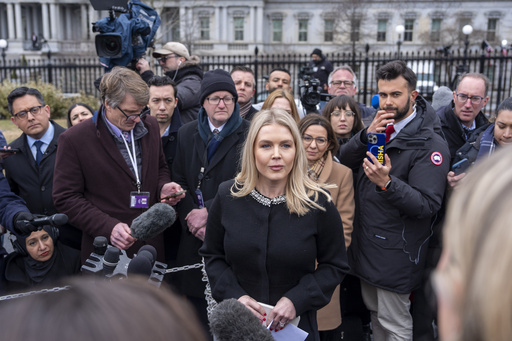
President Donald Trump held an extended meeting with House Republicans at the White House on Thursday, dedicating significant time for them to resolve their differences regarding their expansive multi-trillion-dollar proposal focused on tax cuts, regulatory rollbacks, and reductions in government spending.
Beginning the five-hour meeting, which lawmakers described as notably long, Trump set a positive tone before allowing the group to continue discussions in his absence. Speaker Mike Johnson, however, faced a scheduling conflict as the lengthy session caused him to miss a private meeting with Israeli Prime Minister Benjamin Netanyahu at the U.S. Capitol, which led to the prime minister meeting instead with Democratic leaders while Johnson’s office scrambled to rearrange the meeting.
“Very positive developments today,” Johnson remarked upon returning to Capitol Hill. He expressed gratitude towards the president for his involvement, acknowledging that Trump’s leadership style fostered collaboration among lawmakers.
With Trump’s guidance being sought, GOP leaders in both the House and Senate are looking for clarity on moving forward with their budget bill. However, the president has not detailed specific approaches, opting instead to emphasize the need for effective results from Congress.
This ongoing stalemate has created frustration among Republicans as they watch valuable time pass without significant advancements on their primary objectives now that they hold control in Washington. Simultaneously, congressional offices are inundated with calls opposing Trump’s proposed cuts to various federal programs, including services backed by billionaire Elon Musk.
White House press secretary Karoline Leavitt informed the media that discussions during the meeting centered on “tax priorities of the Trump administration.” This encompassed initiatives like eliminating federal taxation on tips, Social Security benefits, and overtime pay, along with efforts to renew the tax cuts that were first implemented in 2017. “The president is committed to working with Congress to get this done,” Leavitt added.
Despite the narrow majority in the House, Johnson is adamant that Republicans will remain unified to meet his timeline for passing the legislation by April. The chair of the House Budget Committee, Texas Rep. Jodey Arrington, stated that hearings on the proposed package would commence the following week.
As the timeline set by Johnson appears to slip, the Senate is beginning to take a more proactive stance. Republican senators, led by Senate Majority Leader John Thune from South Dakota, are scheduled to gather at Trump’s Mar-a-Lago club for their own discussions on Friday.
GOP senators are advocating for a two-step strategy, which would initiate with a smaller bill incorporating funding for Trump’s border wall and deportation efforts among other issues. This would be followed by a more comprehensive suite of tax breaks to be pursued ahead of the year-end deadline.
Sen. Lindsey Graham, chair of the Senate Budget Committee, announced his intention to advance hearings on this initiative next week.
The diverging approaches between the House and Senate are shaping up to create a competitive atmosphere as each chamber aims to make tangible progress towards the GOP’s overarching objectives.
House Republicans are primarily working towards what Trump has termed a “big, beautiful bill,” which aims to extend approximately $3 trillion in tax cuts set to expire soon. This plan also encompasses other Republican priorities, including funding for mass deportation initiatives and the border wall, alongside significant cuts from various government programs, which are seen as necessary to finance the intended tax cuts.
On the other hand, Graham is proposing a smaller bill totaling roughly $300 billion aimed at funding border security and increasing defense spending, which would largely be financed by rolling back initiatives from the Biden administration aimed at green energy.
Graham expressed confidence that this proposal would provide the financial resources needed to enhance border security and deport undocumented immigrants with criminal records, dubbing it “the most transformational border security bill in the history of our country.”
However, House Republicans are divided on Graham’s approach and have conflicting views within their ranks. While House leadership aims for spending cuts totaling around $1 trillion over the next decade, members of the conservative House Freedom Caucus demand significantly more savings, targeting at least $2.5 trillion during the same period.
Rep. Chip Roy from Texas highlighted his expectation for substantial cuts, advocating for $250 billion annually. He and others in the Freedom Caucus view Graham’s plan as an initial step towards addressing Trump’s immigration and deportation strategies, while the broader tax and spending reduction discussions continue.
However, Arrington emphasized previously that the goal of achieving $2.5 trillion in cuts is likely quite ambitious. Johnson requires almost complete consensus to move forward with any legislation in the face of Democratic opposition, while the Senate maintains a 53-47 Republican majority, allowing little room for disagreement.
Ultimately, Trump’s focus seems to lie more on achieving the desired outcomes than strictly adhering to procedural norms within Congress. This indicates a willingness to adapt as needed to fulfill his administration’s policy goals.

